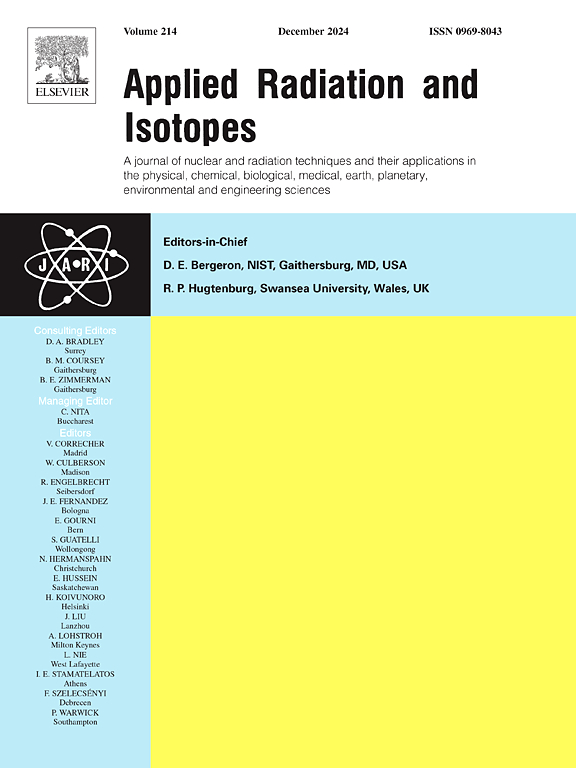A review of photon beam skyshine studies from medical megavoltage accelerators
IF 1.6
3区 工程技术
Q3 CHEMISTRY, INORGANIC & NUCLEAR
引用次数: 0
Abstract
This review examines the literature on the assessment of photon beam skyshine dose rates in medical accelerator radiotherapy with an energy range of 4-25 MV. The selected studies focus on medical accelerators within radiotherapy facilities and employ various methodologies for calculating photon beam skyshine dose rates. Researchers utilized Monte Carlo (MC) simulations, direct measurements, and empirical methods outlined in NCRP Reports 151 and 51 for skyshine estimations. These NCRP reports have established empirical approaches for calculating skyshine dose rates in linac-based radiotherapy settings. The methodologies adopted by different researchers and their findings were compared and discussed. Among these methods, the one that aligns best with measurements across various studies was identified as the gold standard. Notably, the conclusion drawn from multiple papers indicates that NCRP 151 tends to overestimate skyshine dose rates. Various studies were conducted under different geometries and distances from the X-ray source, and comparisons with other works showed consistent results. However, some discrepancies were noted in the results of skyshine characterization studies. This review encompasses publications related to photon beam skyshine from medical accelerators, highlighting that the primary approaches, NCRP 151 empirical methods, MC simulations, and direct measurements, yield reasonable results when multiple methods are employed.
医用超高压加速器的光子束天光研究综述
本文对能量范围为4-25 MV的医用加速器放射治疗中光子束照射剂量率的评估进行了综述。选定的研究集中在放射治疗设施内的医疗加速器上,并采用各种方法计算光子束照射剂量率。研究人员利用蒙特卡罗(MC)模拟、直接测量和NCRP报告151和51中概述的经验方法进行了天光估计。这些NCRP报告已经建立了计算基于直线放射治疗设置的天光剂量率的经验方法。比较和讨论了不同研究人员采用的方法及其研究结果。在这些方法中,与各种研究的测量结果最一致的方法被确定为金标准。值得注意的是,从多篇论文得出的结论表明,NCRP 151倾向于高估日照剂量率。在不同几何形状和距离x射线源的情况下进行了各种研究,并与其他工作进行了比较,结果一致。然而,在天光表征研究的结果中发现了一些差异。本文综述了与医疗加速器的光子束天光相关的出版物,强调了NCRP 151经验方法、MC模拟和直接测量等主要方法在采用多种方法时产生合理的结果。
本文章由计算机程序翻译,如有差异,请以英文原文为准。
求助全文
约1分钟内获得全文
求助全文
来源期刊

Applied Radiation and Isotopes
工程技术-核科学技术
CiteScore
3.00
自引率
12.50%
发文量
406
审稿时长
13.5 months
期刊介绍:
Applied Radiation and Isotopes provides a high quality medium for the publication of substantial, original and scientific and technological papers on the development and peaceful application of nuclear, radiation and radionuclide techniques in chemistry, physics, biochemistry, biology, medicine, security, engineering and in the earth, planetary and environmental sciences, all including dosimetry. Nuclear techniques are defined in the broadest sense and both experimental and theoretical papers are welcome. They include the development and use of α- and β-particles, X-rays and γ-rays, neutrons and other nuclear particles and radiations from all sources, including radionuclides, synchrotron sources, cyclotrons and reactors and from the natural environment.
The journal aims to publish papers with significance to an international audience, containing substantial novelty and scientific impact. The Editors reserve the rights to reject, with or without external review, papers that do not meet these criteria.
Papers dealing with radiation processing, i.e., where radiation is used to bring about a biological, chemical or physical change in a material, should be directed to our sister journal Radiation Physics and Chemistry.
 求助内容:
求助内容: 应助结果提醒方式:
应助结果提醒方式:


